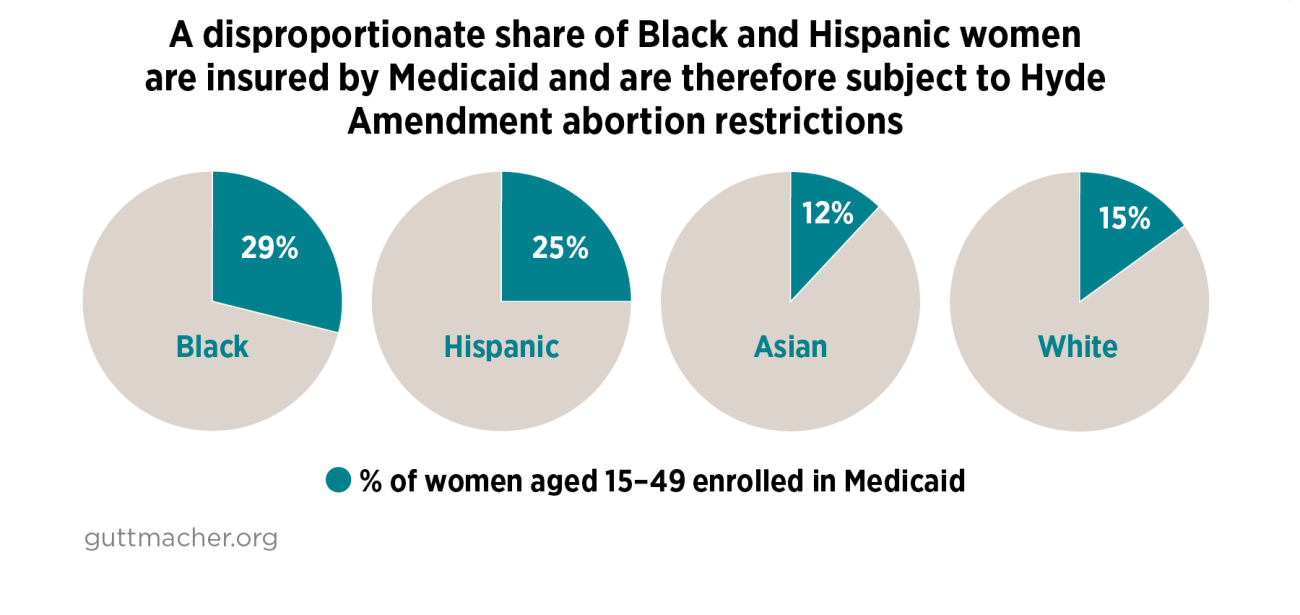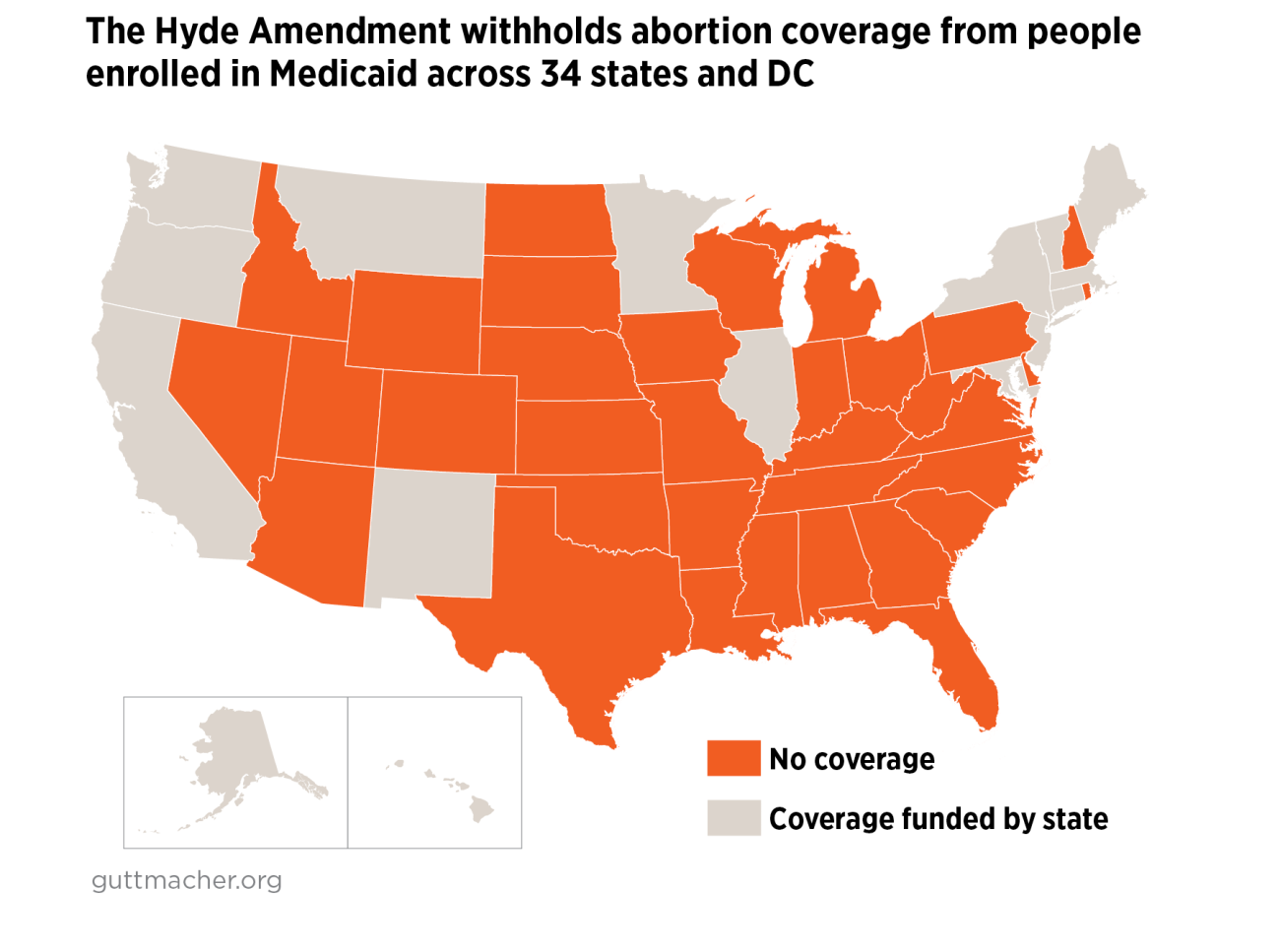Abortion is essential health care and should be affordable for everyone, regardless of income, zip code or source of insurance. But the Hyde Amendment prohibits federal funding for abortion, preventing people enrolled in Medicaid and other public programs in most states from using their health insurance to cover abortion care. The Hyde Amendment disproportionately impacts people already facing systemic barriers to care, particularly Black, Indigenous and other people of color. To ensure it is affordable, abortion should be covered by health insurance—whether public or private and wherever a person lives—which means the Hyde Amendment and related abortion coverage bans must be eliminated.
The Hyde Amendment: A Discriminatory Ban on Insurance Coverage of Abortion
From the series Federal Policy Snapshots
How the Hyde Amendment works
- The Hyde Amendment prohibits federal funds from covering abortion services for people enrolled in Medicaid, Medicare and the Children’s Health Insurance Program (CHIP). It is a discriminatory policy that Congress has included in annual spending bills since 1976.
- The Hyde Amendment currently affects people in 34 states and the District of Columbia. The remaining 16 states provide their own funding for abortion coverage for people enrolled in Medicaid.
- One of the effects of systemic racism in this country is that most women of color are disproportionately likely to have low incomes and to be insured through Medicaid. Among women aged 15–49, 29% of Black women and 25% of Hispanic women were enrolled in Medicaid in 2019, compared with 15% of White women and 12% of Asian women.
- Half of all women aged 15–49 with incomes below the federal poverty level were insured through Medicaid in 2019; for Black women in that group, the proportion was 62%.
- Across the 34 states and the District of Columbia where it currently has an impact, the Hyde Amendment leaves 7.8 million women aged 15–49 with Medicaid coverage but without abortion coverage. Half of those affected are women of color.
- Another cruel consequence of the Hyde Amendment is that related bans withhold abortion coverage from millions of people who obtain their health coverage or care through other federal programs, including federal employees, military personnel and veterans, people imprisoned or detained by the federal government, Native Americans, Peace Corps volunteers and people with low incomes living in the District of Columbia.


Impact of the Hyde Amendment
- On average, an abortion at 10 weeks costs around $550, which could be someone’s entire monthly rent payment, and the cost increases as a pregnancy progresses.
- Many people living with low incomes experience delays obtaining abortion care because of time and effort spent to gather the necessary funds: Fifty-four percent of women in the University of California, San Francisco’s Turnaway Study (which examined the consequences of continuing an unwanted pregnancy compared with receiving an abortion) reported that having to raise money for an abortion delayed their care.
- People seeking an abortion can get caught in a cruel cycle, in which delays associated with raising the money can lead to additional costs and subsequent delays.
- Among women with Medicaid coverage subject to the Hyde Amendment, one in four who seek an abortion are forced to continue the pregnancy.
- Women who do not obtain an abortion they wanted have four times greater odds of subsequently living in poverty and three times greater odds of being unemployed six months later, compared with women who are able to obtain an abortion.
What policymakers can do
To promote equitable access to abortion care, Congress and the Biden-Harris administration must ensure it is affordable for everyone who wants to end a pregnancy. This requires a number of steps, including:
- Removing the Hyde Amendment and related coverage bans from annual spending bills.
- Passing the Equal Access to Abortion Coverage in Health Insurance (EACH) Act to ensure people can obtain insurance coverage of abortion whether they get their coverage or care through Medicaid, Medicare, CHIP or other public programs. The EACH Act would also lift federal restrictions that interfere with private insurance coverage of abortion under the Affordable Care Act and ensure that the federal government does not interfere with insurance coverage of abortion by states, local governments or private health plans.
- Passing the Health Equity and Access under the Law (HEAL) for Immigrant Families Act, which, among other things, would enable all lawfully present immigrants and Deferred Action for Childhood Arrivals recipients to enroll in Medicaid and CHIP if they are otherwise eligible.
- Expanding comprehensive health insurance coverage to those who are currently uninsured. Whether this is done through the Biden-Harris plan or a broader approach like Medicare for All, Congress and the administration must ensure that coverage applies to the full range of reproductive health care, including abortion.
From the series Federal Policy Snapshots
Reproductive rights are under attack. Will you help us fight back with facts?
Read More
U.S. Policy Resources on Abortion
State Funding of Abortion Under Medicaid
In Real Life: Federal Restrictions on Abortion Coverage and the Women They Impact
Guttmacher Policy Review
